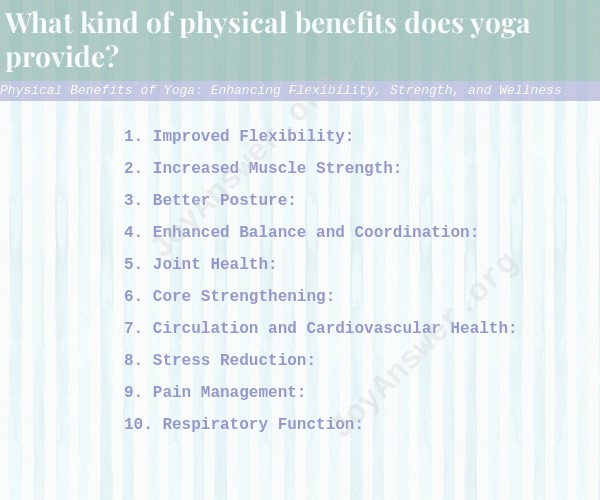What kind of physical benefits does yoga provide?
Yoga offers numerous physical benefits that contribute to overall well-being. Regular practice of yoga can enhance flexibility, strength, and overall physical health. Here's a closer look at how yoga promotes these benefits:
1. Improved Flexibility:Yoga involves a wide range of poses and stretches that target various muscle groups. Through consistent practice, you gradually increase your flexibility by lengthening and stretching muscles and connective tissues. Improved flexibility can enhance your range of motion, reduce muscle stiffness, and decrease the risk of injury.
2. Increased Muscle Strength:Many yoga poses require you to support your body weight in different ways, which can help build strength. Holding poses like plank, warrior, and downward-facing dog challenges various muscle groups, including the core, arms, legs, and back. Over time, this can lead to increased muscle tone and overall strength.
3. Better Posture:Yoga emphasizes body awareness and alignment. Regular practice helps you develop awareness of your body's positioning and alignment, which can carry over into your everyday life. Improved posture can prevent muscle imbalances, reduce strain on the spine, and minimize discomfort.
4. Enhanced Balance and Coordination:Yoga often includes poses that challenge your balance and stability. Balancing poses require you to engage multiple muscle groups to maintain stability. As you practice these poses, your balance and coordination improve, which can translate to better overall body control and stability.
5. Joint Health:Yoga encourages gentle movement and stretching of the joints, which helps maintain their mobility and flexibility. It also promotes the secretion of synovial fluid, which lubricates the joints and supports their health.
6. Core Strengthening:Many yoga poses engage the core muscles, including poses that involve twisting, bending, and balancing. A strong core provides a stable foundation for movement and can reduce the risk of back pain and other discomfort.
7. Circulation and Cardiovascular Health:Certain yoga practices involve dynamic movements that get the blood flowing and increase heart rate. Additionally, relaxation techniques, such as deep breathing and meditation, can help reduce stress and support cardiovascular health.
8. Stress Reduction:Yoga is known for its stress-reduction benefits. Lowering stress levels can have a positive impact on physical health by reducing muscle tension, improving sleep quality, and supporting the immune system.
9. Pain Management:Yoga's gentle stretches and poses can be therapeutic for individuals dealing with chronic pain conditions like lower back pain, arthritis, or fibromyalgia. It helps alleviate tension, improve circulation, and promote relaxation.
10. Respiratory Function:Yoga emphasizes conscious and controlled breathing techniques. These techniques can enhance lung capacity, improve respiratory function, and increase oxygen intake.
Remember that progress in yoga is gradual, and it's important to practice safely and listen to your body. Whether you're a beginner or an experienced practitioner, yoga offers a holistic approach to physical well-being that can positively impact various aspects of your health.












